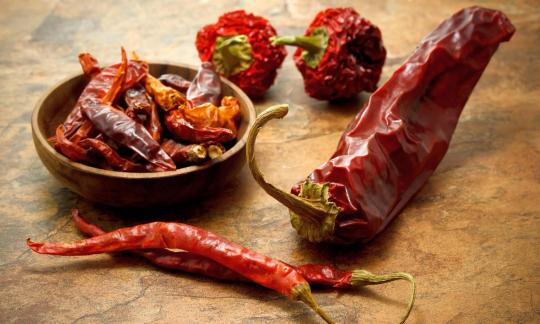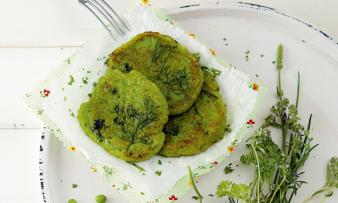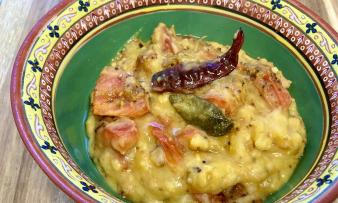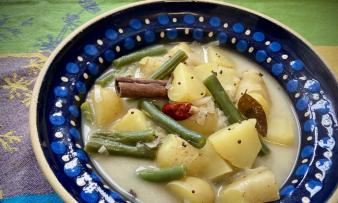Table of contents
Sun-dried chili peppers are whole raw chili peppers ( organic) that are dried in the sun, which greatly increases their shelf life. The classification is not always clear, as the genus Paprika includes many species: For example, the botanical names for chili peppers are Capsicum annuum, Capsicum frutescens (hotter variety) and others.
Using chili peppers in the kitchen:
Sun-dried chili peppers (hot peppers) are used as a seasoning in many different dishes. Since dried chili peppers are dehydrated, they are hotter than raw peppers just before drying. However, depending on the type of chili, the spiciness of raw chilies can vary greatly. You can find tips on dosage and spiciness under the ingredient chili peppers, red, raw.
In addition to their spiciness, the different types of peppers have complex flavors that range from smoky, lemony, chocolatey, earthy to mushroomy. The dried fruits are available in different colors (from orange-red to purple-black) and sometimes raw.
Sun-dried or dried chili peppers can be added whole to soups, stews, curries, pasta water or sauces and simmered to add flavour. Or you can grind them into chili flakes and cayenne pepper or fine chili powder to season dishes. Another way to use dried chili is to rehydrate it. To do this, remove the seeds and fry the chili in a pan for around 30 seconds. Put the fruit in boiling water and leave to swell for 15-30 minutes, depending on how thick the chili is. Chopped up or pureed into a paste, it can now give dishes a fiery spiciness.
Other ways of using the pods include soaking them in oil or vinegar. Dried chili peppers can also be used as a topping on raw salads, vegan pizza (as pizza pepper) and on dishes with avocado. But the spicy pods go well with desserts as well as savoury dishes. Chili can be used well in fruity desserts with mango, in dark chocolate or in spice cakes.
Vegan recipe for chili chocolate sorbet:
Ingredients (for 2 people) : 125 g kumquats, 1 large orange (100 ml orange juice), 70 g dark chocolate (at least 70% cocoa content), 50 g cane sugar, 2 tbsp cocoa powder (organic), 2 tbsp agave syrup, possibly 2 tbsp amaretto, 1 small chili pepper (sun-dried, organic), ½ vanilla pod.
Preparation: First, finely chop the chocolate. Cut the chilli pepper (dried) lengthways, remove the seeds and finely crumble the pod. Mix the cocoa powder, sugar and 250 ml of water in a saucepan and bring to the boil over medium heat. Remove the pan from the heat and stir in the chopped chocolate and chopped chilli. Next (add the Amaretto and) put the mixture in an ice cream maker for 20 minutes. In the meantime, rinse the kumquats with hot water, cut into thin slices and remove the seeds. Halve the orange and squeeze the juice. Measure out 100 ml of orange juice and set aside. Scrape the pulp out of the vanilla pod and bring to the boil briefly with the agave syrup. Now add the kumquats. Stir in the orange juice, simmer the mixture for 10 minutes and then allow to cool. Serve the vegan chocolate sorbet with the kumquat compote.
Vegan recipes with sun-dried chili peppers can be found under the note: " Recipes that have the most of this ingredient ".
| Not only vegans or vegetarians should read this: Vegans often eat unhealthily. Avoidable nutritional mistakes. |
Shopping - where to buy chili peppers (dried)?
Whole, dried chili peppers are available in some supermarkets such as Coop, Migros and Rewe (often as: dried peppers, whole dried peperoncini, whole dried peppers, dried peppers etc.). Organic supermarkets ( Denn's Biomarkt, Alnatura), organic shops, weekly markets or specialty shops (e.g. Turkish supermarkets) also usually have the spicy fruits in their range. Online you can choose from a variety of dried chili varieties, often in organic quality (bio).
Chili spice mills, chili flakes and cayenne pepper (ground chilies) can be found almost everywhere, e.g. in Denner, Volg, Spar, Aldi, Lidl, Edeka, Hofer, Coop, Rewe, Migros etc.; in online stores also as organic goods (bio).
It is difficult to verify whether purchased sun-dried peppers are still raw food quality. In general, the term raw food is not subject to any controls and a great deal of trust is placed in the producers. Even with so-called "gentle" drying in the sun, very high temperatures can arise, in which case the dried chili peppers are no longer considered raw.
Making your own sun-dried chili peppers:
If you want to dry chili peppers yourself, you should use thin-walled chilies (e.g. Cayenne chili, Tabasco chili or Thai Dragon) as these dry more quickly. Chili peppers with thick flesh can easily develop mold as the moisture stays in the flesh for too long. 19 Always wear gloves when working with chili peppers to avoid skin irritation.
Drying in the sun is highly dependent on the weather. You need hot summer days with little rainfall, low humidity and a lot of sunlight. There are various methods you can use to make sun-dried chili peppers:
In the first method , the pods are dried on a smooth surface. It is important that the chilies do not overlap. The pods can be dried whole or halved. Halved pods take significantly less time to dry (3-5 days), but whole chilies have the advantage that the flesh is protected from dust and flies. Once the chili is completely dry, it can be stored in a dark, dry place. 1
The second method involves letting the chilies dry on a line. To do this, use a needle to thread the pods onto their stems. Leave enough space between the individual chilies so that they can dry evenly. Hang the line in the sun. Depending on the type and thickness of the chili peppers, the intensity of the sun and the humidity, the chilies need 2-3 weeks for the drying process. 1
Tying them together to form ristras is another way to dry fresh chilies. Many cultures believe that tied ristras bring good luck in the kitchen. When making a chili ristra, the fresh pods are tied together in a specific pattern. To make the red chili strands yourself, you need fresh chilies, a thread about 1 m long and a thick needle. Tie a thick knot at the end of your thread so that the chili peppers don't slip down. Thread the other end of the thread onto the needle. Guide the needle through the stems at a 45-degree angle close to the crown, starting with the smallest fruit and threading larger and larger chilies upwards. The chili peppers need sun to dry. They should be completely dry within 14 days. The individual strands can be twisted together, then they look even more artistic and decorative. 19
Drying in the sun can result in high temperatures. If you want guaranteed raw food, you can also use a dehydrator.
Storage:
Since fresh chili peppers only last up to two weeks, dried chilies are a good alternative. This increases their shelf life to 1 year. Once the chili is dried, it should be stored in a cool, dark and dry place to prevent the pods from rotting and molding too early. 1 It is also possible to store the dried peppers in the form of ristras (chili strings). A high-quality chili should not be completely dried out, but should still be easy to bend without breaking.
Ingredients - Nutritional values - Calories:
Chili peppers, sun-dried, contain 324 kcal per 100 g. The pod consists of 70 g/100 g of carbohydrates, which are made up of sugar (41 g/100 g) and fiber (29 g/100 g). Dried chili peppers therefore have significantly more fiber and sugar than fresh ones (1.5 g fiber, 5.3 g sugar). Chili peppers contain 5.8 g fat and 11 g protein. Onion granules contain a similar amount of protein (10 g), and dried tomatoes contain a little more (14 g). 2
The amount of minerals and trace elements should not be underestimated. However, we consume so little dried peppers that these figures are negligible. Sun-dried chili peppers contain 1,324 µg of vitamin A (as RAE) per 100 g and would therefore cover 166% of the daily requirement. Dried goji berries contain a similar amount (1,341 µg/100g). Even more can be found in fenugreek leaves (2,104 µg/100g). 2
The vitamin K content (108 µg/100g) is comparable to that of rocket (raw, 109 µg/100g). This value is exceeded by dried basil (1,714 µg), for example. 2
Potassium content : Dried peppers contain 1,870 mg of potassium per 100 g. In comparison, dried coriander leaves (4,466 mg) or dried parsley (2,683 mg/100g) contain significantly more. 2
Chili peppers contain the active ingredient capsaicin, which is responsible for their spiciness. The Scoville scale is used to determine the spiciness. With 2,200,000 Scoville (rarely up to around 3,000,000 Scoville units), the Carolina Reaper is considered the hottest fruit in the world. 3 You can find out more about the Scoville scale in the article Chili peppers, red, raw (organic?).
The complete ingredients of dried chili peppers, the coverage of the daily requirement and comparison values with other ingredients can be found in our pepper pictogram nutrient tables in the CLICK FOR under the ingredient picture.
Health aspects - effects:
Is dried chili healthy? Depending on the variety, dried peppers contain little to a lot of the secondary plant substance capsaicin (alkaloid), 5 which determines the spiciness. Capsaicin increases the secretion of gastric juice and stimulates saliva flow and digestion. Capsaicin can also lift the mood and boost energy consumption, thus promoting weight loss. Since the alkaloid has an antioxidant, anti-inflammatory and antibacterial effect, it can reduce the risk of cancer. 4 Eating hot peppers can lead to increased blood flow, but can also trigger hot flashes and sweating. 6
Sun-dried chili peppers contain other secondary plant substances, such as flavonoids 6 and carotenoids. The pigments capsanthin, capsorubin and lutein, which are responsible for the red color of the peppers, act as antioxidants and can protect against UV light. 7
The bioavailability of carotenoids depends on factors influencing the food and how it is prepared and processed. The factors influencing the food are the subject of current research and cannot be influenced by the consumer. 8,9,10,11 On the other hand, the careful preparation of a food can noticeably increase the absorption of carotenoids. Chopping plays the biggest role here (for details, see carrot, raw). 8,12
Dangers - Intolerances - Side effects:
Excessive use of the active ingredient capsaicin can lead to irritation of the mucous membranes (stomach irritation), nausea, vomiting, diarrhea or high blood pressure, as well as tears, a runny nose and breathing and swallowing problems. The Federal Institute for Risk Assessment assumes that an adult can tolerate a maximum of 5 mg of capsaicin per kg of body weight. For a person weighing 60 kg, this amounts to 300 mg of capsaicin per meal. External use can cause local skin irritation. 13
People with sensitive stomachs and children should also consume hot chilies with caution, otherwise they may experience heartburn and diarrhea. In small children, ingesting chilies can lead to serious poisoning 13.
The capsaicin contained in dried peppers can trigger allergic skin reactions as well as cross-allergies to tree pollen (e.g. birch, alder, hazel), 14 but cross-reactions to mugwort pollen are also possible. 15 Cross-allergies are usually milder than main allergies. Similar reactions are also observed with red, raw bell peppers.
Use as a medicinal plant:
Capsaicin has a digestive effect and can help with rheumatism and muscle pain in the form of ointments and plasters. 16 If your feet are cold, you can use the spicy fruits to improve blood circulation, for example by using warming insoles with chili. Skiers and hikers are also said to use chili to warm their feet. 17
Occurrence - Origin:
The pepper species probably originally came from South America. In the 16th century, Columbus brought the plant to Europe. Today, peppers are grown in subtropical and temperate zones all over the world. The main producers are Mexico, India, Indonesia, Thailand, Japan and China. 18 But chili peppers are also grown in Europe - especially in Spain, Italy and the Netherlands. In 2016, India produced the most dried chili peppers.
General information about chili peppers:
The genus Capsicum belongs to the nightshade family (Solanaceae) and consists of around 30 different types of pepper, of which 5 are mainly cultivated. The classification of pepper species is not always clear. The Capsicum annuum species includes both mild and hot pepper varieties. However, there are even hotter varieties of the Capsicum frutescens species. In addition to countless wild varieties , Capsicum baccatum, Capsicum chinense (hot pepper / Tabasco pepper) and Capsicum pubescens are also grown, mainly in Central and South America. The number of different types of chili worldwide is estimated at 3,000-4,000 variations, which differ in size, fruit shape, thickness of the pulp, color and capsaicin content (chili spiciness). 20
Alternative names:
Chili peppers are also known as red pepper, Spanish pepper, spice peppers, pepperoni, peppers, pepperones, peperoncini, red pimento, chili or cayenne pepper.
The questions "pepperoni vs chili difference?" and "pepperoni vs chili difference?" can be answered as follows: pepperoni and pepperoni are both synonyms used for the term paprika (bell pepper). In South Tyrol or Switzerland people tend to say "pepperoni", in Austria the term "pepperoni" is more common. Milder cultivated varieties are usually considered sweet peppers (or spice peppers) and hot varieties are considered chilis (chili peppers), but the line is fluid.
Historically documented names for Capsicum annuum are: Brunsilgen pepper, curry, Guinea pepper, hen pepper, cap pepper, Negro pepper, Brazilian pepper, Hispanic pepper, Indian-Kalickutt pepper and Polterhannes. 21 For chilis of the species Capsicum frutescens one also finds the name Beissbeere (biting berry).
The frequently encountered spelling with a space (chili pepper, chili pepper) is not orthographically correct. Chili pepper is written with a hyphen or in one word: chili pepper. More on this under chili pepper, red, raw. The word chili is masculine, but you can also find feminine formulations online such as: a dried chili, the hottest chili in the world.
In English, hot dried peppers are called dried capsicum, dried red pepper, dried chili, dried chilli (plural: chilies or chillies), dried chile pepper or cayenne pepper.
The names used for the drug are bloat fruit and Capsici fructus. 16
Literature - Sources:
Bibliography - 21 Sources
| 1. | Thekitchenprofessor.com How to Sun Dry Chili Peppers. May 5, 2021. By Amy Spencer. |
| 2. | USDA United States Department of Agriculture. |
| 3. | Moñoz-Ramirez LS, Peña L, Avilés-Viñas SA et al. Behavior of the hottest chili peppers in the world cultivated in yucatan, mexico. HortScience 2018; 53(12): 1772-1775. |
| 4. | Srinivasan K. Biological activities of red pepper (Capsicum annuum) and its pungent principle capsaicin: a review. Crit Rev Food Sci Nutr. 3. Juli 2016;56(9):1488–500. |
| 5. | Rätsch C. Enzyklopädie der psychoaktiven Pflanzen. Botanik, Ethnopharmakologie und Anwendung. AT Verlag: Aarau. 14. Aufl. 1998. |
| 6. | Pamplona Roger JD. Heilkräfte der Nahrung, Praxishandbuch. Advent-Verlag Zürich. 3. Auflage 2008. |
| 7. | Fernández-García E, Carvajal-Lérida I, Pérez-Gálvez A. Carotenoids exclusively synthesized in red pepper (Capsanthin and capsorubin) protect human dermal fibroblasts against UVB induced DNA damage. Photochem Photobiol Sci. 31. August 2016;15(9):1204–11. |
| 8. | Priyadarshani AMB. A review on factors influencing bioaccessibility and bioefficacy of carotenoids, Critical Reviews in Food Science and Nutrition. 2017; 57(8): 1710-1717. |
| 9. | Castenmiller JJM, West CE. Bioavailability and bioconversion of carotenoids. Annu. Rev. Nutr. 1998; 18:19–38. |
| 10. | Yeum KJ, Russell M. Carotenoid bioavailability and bioconversion. Annu. Rev. Nutr. 2002; 22: 483–504. |
| 11. | Unlu NZ, Boh T, Clinton SK et al. Carotenoid absorption from salad and salsa by humans is enhanced by the addition of avocado or avocado oil. J. Nutr. 2005; 135:431–436. |
| 12. | Hedrén E, Diaz V., Svanberg U. Estimation of carotenoid accessibility from carrots determined by an in vitro digestion method. Eur J Clin Nutr. 2002; 56: 425–430. |
| 13. | Bfr.bund.de. Zu scharf ist nicht gesund. 2011. |
| 14. | Gesundheit.gv.at Öffentliches Gesundheitsportal Österreichs. Kreuzallergien. 2018. |
| 15. | Ernaehrung.de DEBInet Deutsches Ernährungsberatungs- & -informationsnetz. Nahrungsmittelallergien - Pollen. Siehe unter: Pollenassoziierte Nahrungsmittelallergien. |
| 16. | Pahlow M. Das grosse Buch der Heilpflanzen. Nikol Verlagsgesellschaft, 9. Auflage 2020. |
| 17. | Kraeuterabc.de Chili. Capsicum frutescens, Capsicum annuum, Capsicum sp. Letzte Änderung: 18. Februar 2021. |
| 18. | Rehm S, Espig G. Die Kulturpflanzen der Tropen und Subtropen. Verlag Eugen Ulmer: Stuttgart. 1976. |
| 19. | Chilipflanzen.com Trocknen von Chilis und Peperoni an der Luft. Letzte Bearbeitung am 17.11.2019. |
| 20. | Brücher H. Tropische Nutzpflanzen. Ursprung, Evolution und Domestikation. Springer Verlag. Berlin. 1976. |
| 21. | Pritzel GA, Jessen C. Die deutschen Volksnamen der Pflanzen. Neuer Beitrag zum deutschen Sprachschatze. Cohen P.: Hannover. 1882: 78. |











Comments